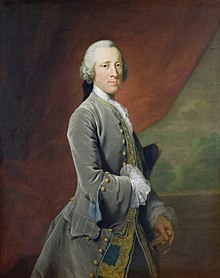Lord Lieutenant of Ireland
The Lord Lieutenant of Ireland [ lɔːd lɛfˈtɛnənt əv ˈaɪələnd ] ( plural : Lords Lieutenant ; Irish Fear Ionaid an Rí ), also known as the Justiciar in the early Middle Ages or as Lord Deputy until the 17th century, was the representative of the English King and Head of the Irish Executive during the Lordship of Ireland (1171–1541), the Kingdom of Ireland (1541–1800) and the United Kingdom of Great Britain and Ireland (1801–1922). Even as the head of a theoretically independent Irish kingdom, the Lord Lieutenant (or Judiciar or Lord Deputy) was always a representative of the English crown and did not have to answer to the Irish Parliament or the Irish people.
The holder of the office, which had three different official titles over time, was known in common parlance as viceroy (viceroy; from the French vice roi ) or deputy king (deputy king).
The first Lord Deputies were Irish nobles. Since the Middle Ages, with very few exceptions, the incumbents have been English or British nobles.
tasks
The royal representative had a number of overlapping duties:
- Representation of the king
- Head of the Executive in Ireland
- (partially) member of the British or British Parliament
- (partially) Commander- in -Chief in Ireland
- Grand Master of the Order of Saint Patrick
Before the Act of Union of 1800, which abolished the Irish Parliament, the Lord Lieutenant proclaimed government guidelines in the speech from the throne . The Lord Lieutenant had effective control of Parliament and bestowed titles of nobility, baronets and various state honors. Critics therefore accused various incumbents of having bought parliament with the help of nobility; in July 1777, the Lord Lieutenant John Hobart , 2nd Earl of Buckinghamshire , promoted five Viscounts to Earls and seven barons to Viscounts and appointed 18 new barons. The title was also used to convince MPs to endorse the Act of Union .
Constitutional structures
The Lord Lieutenant was advised within the government by the Irish Privy Council , a body that usually met at Dublin Castle . The Lord Lieutenant was also supported by the following offices:
- Chief Secretary for Ireland - originally first advisor to the Lord Lieutenant; Since the end of the 19th century, however, in principle the Prime Minister of the government with the Lord Lieutenant as the personal representative of the constitutional monarch in a (predominantly) representative and advisory role.
- Under Secretary for Ireland - Chairman of the Public Service in Ireland
- Lord Justice - three incumbents who acted on behalf of the Lord Lieutenant in his absence. Before 1800 the Lords Justice were the Lord Chancellor of Ireland , the Speaker of the Irish House of Commons and the Archbishop of Armagh of the Church of Ireland , the "Primate of All Ireland"
Term of office
Lord Lieutenants had no fixed term of office but remained in office for as long as the British Government pleased. After the fall of a government, the Lord Lieutenant was usually replaced by a supporter of the new government.
Official
Irish or Anglo-Irish nobles (e.g. Gearoid Mór Fitzgerald , 8th Earl of Kildare ) traditionally held the office of Lord Deputy until the 1500s , but after the start of the Plantations the office went to English with a few exceptions Nobles over. The last Irish Catholic in this office was Richard Talbot, 1st Earl of Tyrconell from 1685 to 1691 .
No English Lord Lieutenant lived in Ireland until the 1780s. Instead, they merely traveled to meetings of the Irish Parliament in Dublin , which it did for a few months every two years. Only then did the English cabinet decide that a steady presence in Ireland was necessary for the office in order to regulate public affairs in Ireland.
Only English or British nobles could become Lord Lieutenant. After the Glorious Revolution , only Anglicans could hold this office, even though the majority of the Irish population were Catholics . It was not until 1921 that Edmund FitzAlan-Howard, 1st Viscount FitzAlan of Derwent, became a Catholic Lord Lieutenant again; he was the last incumbent.
meaning
The importance of this office has fluctuated over time. Sometimes the post was just a sideline for English politicians who had fallen out of favor in Westminster Parliament , in other years it was an important career move. Two Lords Lieutenant ( William Cavendish and William Henry Cavendish-Bentinck ) moved from Dublin directly to London as Prime Minister.
In the middle of the 19th century the political importance of the office was reduced to a symbolic post that watched over the Irish administration, but did not command it. Instead, the Chief Secretary of Ireland became increasingly important.
residence
The official residence of the Lord Lieutenant was Dublin Castle . Summer residences were Abbeville in Kinsealy , Chapelizod House and St. Wolfstan's in Lucan . Lords Deputy Gearoid Mór Fitzgerald and Gearoid Óg Fitzgerald (both Irish by birth ) also lived in their castle in Maynooth in County Kildare .
After the Lord Lieutenant had to live permanently in Ireland, a change of quarters became necessary. In 1781 the British government bought a residence in Phoenix Park in Dublin, which they converted and renamed Viceregal Lodge (now the residence of the Irish President: Áras an Uachtaráin ). But it was not until the 1820s that the building was regularly inhabited by the Lords Lieutenant.

